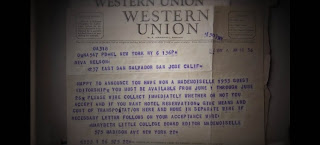Fifty-five years after its first publication, Sylvia Plath's The Bell Jar has received a serious, respectful, and authoritative consideration in the form of Sylvia Plath: Inside The Bell Jar which features the first video interview by Frieda Hughes on her mother. And my, was she and it insightful, humble, humorous: just spectacular. The on camera reminiscences by Plath's friends: Janet Salter Rosenberg, Elinor Friedman Klein, Betsy Powley Wallingford, Laurie Glaser, Neva Nelson Sachar, Phil McCurdy, Perry Norton, and Melvin Woody were superb. Some of these friends appeared on camera, as well, for the first time ever. They offer authentic, personable, and emotional memories of their friend Sylvia Plath and what life was like in the 1950s and early 1960s. These were connected with commentary by Heather Clark, Karen V. Kukil, and Tristine Skyler.
Inside The Bell Jar was sensitivity produced. It has left me in tears (particularly Phil McCurdy and Betsy Wallingford at the end) both times I have seen it in the last 24 hours. There is very little criticize; however, there is one thing worthy mentioning in case it can be corrected. The excerpts of the letters read in the program were inconsistently identified. The one to Ann Davidow-Goodman was fully dated; the one to Aurelia Schober Plath, incompletely dated; and the letter to Eddie Cohen not dated at all.
 |
| Letter to Ann Davidow-Goodman, 18 February 1952 |
 |
| Letter to Aurelia Schober Plath, 13 June 1953 |
 |
Letter to Eddie Cohen, 28 December 1953
|
 |
| Telegram from Marybeth Little, Mademoiselle to Neva Nelson, 6 May 1953 |
 |
| Telegram from Marybeth Little, Mademoiselle to Sylvia Plath, 6 May 1953 |
Plath's pseudonym, Victoria Lucas, was not mentioned at all; neither was an image of the first edition shown. These could have been mentioned during the segment when the reviews of the novel were discussed. Quite minor quibbles in an otherwise fine production.
 |
| The Bell Jarby Victoria Lucas, Heinemann, 1963 |
 |
| The plaque at Wellesley High School installed in November 2000 for the 50th anniversary of the class of 1950. |

